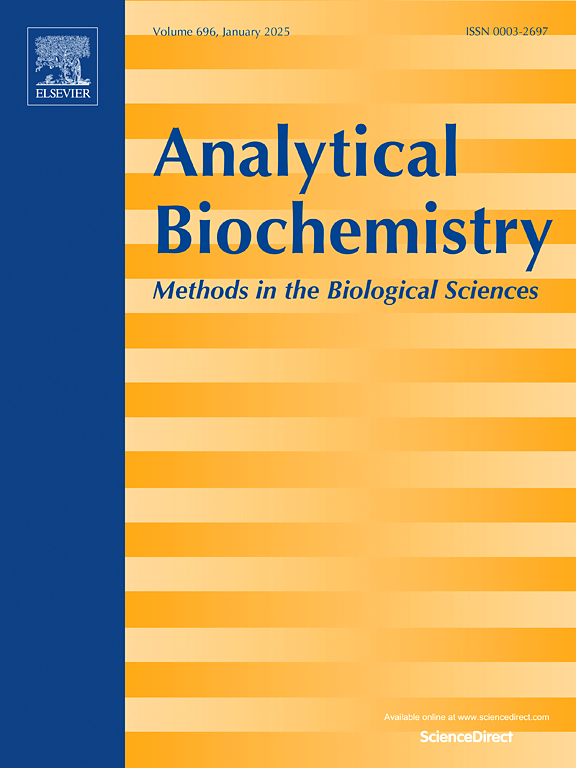优化免疫沉淀后人脑组织中新型截断α-突触核蛋白的质谱鉴定。
IF 2.5
4区 生物学
Q2 BIOCHEMICAL RESEARCH METHODS
引用次数: 0
摘要
α-突触核蛋白是神经退行性疾病的核心蛋白,其功能受到多种翻译后修饰的影响。质谱法是表征α-突触核蛋白形式的有力手段,但需要事先有效的免疫沉淀条件。在这项研究中,我们通过评估影响回收率和特异性的关键参数,完善了从人脑组织中提取α-突触核蛋白的免疫沉淀。我们评估了toyl活化磁珠与绵羊抗体磁珠的性能,确定了提高结合效率的最佳磁珠类型。严格测试了各种洗脱条件,以最大限度地提高蛋白质产量。我们还评估了一系列α-synuclein特异性抗体,并描绘了抗体数量和头体积对α-synuclein恢复的影响。优化后的免疫沉淀方案与高分辨率质谱法有效结合,用于表征帕金森病患者和对照组脑源性α-突触核蛋白。该分析共鉴定出38种N端或c端截断的α-突触核蛋白形式,包括22个新位点。我们的研究结果为从复杂的生物基质中可靠地富集和表征α-突触核蛋白提供了分析工具,在发现生物标志物和研究突触核蛋白病的致病机制方面具有潜在的应用价值。本文章由计算机程序翻译,如有差异,请以英文原文为准。

Mass spectrometric identification of novel truncated α-synuclein species following optimized immunoprecipitation from human brain tissue
α-synuclein is a protein central to neurodegenerative diseases, and its functions are affected by multiple posttranslational modifications. Mass spectrometry is powerful for the characterization of α-synuclein forms but requires prior efficient immunoprecipitation conditions. In this study, we refined the immunoprecipitation of α-synuclein from human brain tissues by evaluating key parameters that influence recovery and specificity. We assessed the performance of tosyl-activated magnetic beads versus sheep antibody beads, identifying the optimal bead type for enhanced binding efficiency. Various elution conditions were rigorously tested to maximize protein yield. We also evaluated a range of antibodies specific to α-synuclein and delineated the effects of antibody amount and bead volume on the recovery of α-synuclein. The optimized immunoprecipitation protocol was effectively combined with high-resolution mass spectrometry for characterizing brain-derived α-synuclein from Parkinson's disease patients and controls. The assay identified a total of 38 N- or C-terminal truncated α-synuclein forms, including 22 novel sites. Our findings provide analytical tools for the reliable enrichment and characterization of α-synuclein from complex biological matrices, with potential applications in biomarker discovery and the investigation of pathogenic mechanisms underlying synucleinopathies.
求助全文
通过发布文献求助,成功后即可免费获取论文全文。
去求助
来源期刊

Analytical biochemistry
生物-分析化学
CiteScore
5.70
自引率
0.00%
发文量
283
审稿时长
44 days
期刊介绍:
The journal''s title Analytical Biochemistry: Methods in the Biological Sciences declares its broad scope: methods for the basic biological sciences that include biochemistry, molecular genetics, cell biology, proteomics, immunology, bioinformatics and wherever the frontiers of research take the field.
The emphasis is on methods from the strictly analytical to the more preparative that would include novel approaches to protein purification as well as improvements in cell and organ culture. The actual techniques are equally inclusive ranging from aptamers to zymology.
The journal has been particularly active in:
-Analytical techniques for biological molecules-
Aptamer selection and utilization-
Biosensors-
Chromatography-
Cloning, sequencing and mutagenesis-
Electrochemical methods-
Electrophoresis-
Enzyme characterization methods-
Immunological approaches-
Mass spectrometry of proteins and nucleic acids-
Metabolomics-
Nano level techniques-
Optical spectroscopy in all its forms.
The journal is reluctant to include most drug and strictly clinical studies as there are more suitable publication platforms for these types of papers.
 求助内容:
求助内容: 应助结果提醒方式:
应助结果提醒方式:


